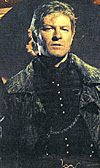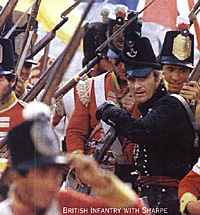Richard Sharpe
 Richard Sharpe (at right, as depicted by actor Sean Bean) was born in London in 1777, the son of a whore and unknown father. His mother died when he was young, and he was brought up as an orphan before trying his hand as a thief and pickpocket. In 1793, he killed an innkeeper and sought refuge in the one place where awkward questions would not be asked -- the army.
Richard Sharpe (at right, as depicted by actor Sean Bean) was born in London in 1777, the son of a whore and unknown father. His mother died when he was young, and he was brought up as an orphan before trying his hand as a thief and pickpocket. In 1793, he killed an innkeeper and sought refuge in the one place where awkward questions would not be asked -- the army.
Sharpe joined the ranks of the 33rd Foot and took part in the Duke of York's campaign in Flanders, fighting many battles against the French at Boxtel in 1795, before sailing with the regiment to India in the following year. He took part in the storming of Seringapatam in 1799, killing the Tippoo Sultan, promoted to the rank of Sergeant.
 Four lears later, he saved the life of Sir Arthur Wellesley, the future Duke of Wellington, at the battle of Assaye and was rewarded with a promotion to ensign in the 74th Highlanders. Sharpe this discovered by accident the one opportunity to overcome the disadvantages oflow birth.
Four lears later, he saved the life of Sir Arthur Wellesley, the future Duke of Wellington, at the battle of Assaye and was rewarded with a promotion to ensign in the 74th Highlanders. Sharpe this discovered by accident the one opportunity to overcome the disadvantages oflow birth.
On returning home, the now Lt. Sharpe transferred to the 95th Rifles and in 1808 he embarked for the Peninsula. Separated from his regt during the retreat to Corunna, he was gazetted to captain in the South Essex following a skirmish with French cavalry in 1809, and servedwith that regt for the next six years.
 He continued to show his reckless personal courage, capturing an eagle at Talevera and leading the storming parties into the breeches at Batajoz in 1812, but also a growing professional judgement and the ability to command troops, holding back a French counterattack at Salamanca and cutting off a French retreat at Vittoria in 1813. His escapades brought him to the attention of the Prince Regent, who promoted him to the rank of major in 1812.
He continued to show his reckless personal courage, capturing an eagle at Talevera and leading the storming parties into the breeches at Batajoz in 1812, but also a growing professional judgement and the ability to command troops, holding back a French counterattack at Salamanca and cutting off a French retreat at Vittoria in 1813. His escapades brought him to the attention of the Prince Regent, who promoted him to the rank of major in 1812.
A the war progressed, Sharpe was drawn into the world of political and military intrigue. In 1810, he retrieved a consignment of Spanish goldin order to help pay for the construction of the lines of Torress Vedras and in 1812 he was assigned to protect a spy, El Mirador, whose network of agents gathered vital intelligence for the British across Europe. This work brought him into increased conflict with Prince Ducos, Napoleon's chief intelligence officer in Spain. In 1813, he was an unwilling pawn in the Frenchman's plan to break the alliance between Britain and Spain, when he was accused of murdering a Spanish noblewoman.
Sharpe was weary of war when peace came in 1814. After finally settling his account with Docus, who had arranged for him to be court-martialed for allegedly stealing a consignment of Napoleon's treasure on its way to Elba, he settleddown to a fam lifein a chateau in Normandy. However, when the Emperor escaped from exile in 1815, he rejoined the army and was assignedto the staff of Prince of Orange. He fought at Quatre Bras and Waterloo, and ended the campaign in command of the South Essex.
Sharpe's military career would probably have been short and unspectacular but for his almost suicidal bravery and enormous good luck. Very few men gained promotion from the ranks, and fewer still were able to overcome the mistrust and prejudice of their fellow officers and the men whom they commanded. He owedmuch to the continued patronage of the Duke of Wellington, who guided his career with an often unseen hand, and there continued to be a strong bond between the two men who had shared so many battlefields. Yet in the end, it was Sharpe's own professionalism and determination that enabled him to succeed and to win the respect of his peers.
More Sharpe
-
Sharpe's Weapons: Introduction
Sharpe's Weapons: Richard Sharpe
Sharpe's Weapons: Firearms
Sharpe's Weapons: Swords
Back to Age of Napoleon No. 28 Table of Contents
Back to Age of Napoleon List of Issues
Back to MagWeb Master List of Magazines
© Copyright 1998 by Partizan Press.
This article appears in MagWeb (Magazine Web) on the Internet World Wide Web.
Other military history articles and gaming articles are available at http://www.magweb.com